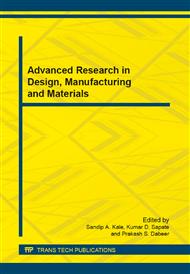[1]
F. Fahy, J. Walker J. Advanced applications in acoustics, noise and vibration. Taylor & Francis, New York, 2004.
Google Scholar
[2]
M. V. Gandhi, B. S. Thompson. Smart materials and structures. Springer; 1992.
Google Scholar
[3]
J. Lin, W. Z. Liu. Experimental evaluation of a piezoelectric vibration absorber using a simplified fuzzy controller in a cantilever beam. J. Sound Vibr. 296 (2006) 567-582.
DOI: 10.1016/j.jsv.2006.01.066
Google Scholar
[4]
M. Sharma, S. Singh, B. Sachdeva. Modal control of a plate using a fuzzy logic controller. Smart Mater. Struct. 16 (2007) 1331.
DOI: 10.1088/0964-1726/16/4/047
Google Scholar
[5]
Y. Zhang, H. Niu, S. Xie, X. Zhang. Numerical and experimental envestigation of active vibration control in a cylindrical shell partially covered by a laminated PVDF actuator. Smart Mater. Struct. 17 (2008) 1-12.
DOI: 10.1088/0964-1726/17/3/035024
Google Scholar
[6]
S.S. Rao, M. Sunar. Analysis of distributed thermopiezoelectric sensors and actuators in advanced intelligent structures. AIAA J. 31 (1993) 1280-1286.
DOI: 10.2514/3.11764
Google Scholar
[7]
S. Raja, K. Rohwer, M. Rose. Piezothermoelastic modelling and active vibration control of laminated composite beams. J. Intell. Mater. Sys. Struct. 10 (1999) 890-899.
DOI: 10.1106/gppm-h4fu-8wue-g63k
Google Scholar
[8]
H. J. Lee, D. A. Saravanos. A mixed multi-field finite element formulation for thermopiezoelectric composite shells. Int. J. Solids Struct. 37 (2000) 4949-4967.
DOI: 10.1016/s0020-7683(99)00192-4
Google Scholar
[9]
S. Raja, P. K. Sinha, G. Prathap, D. Dwarakanathan. Thermally induced vibration control of composite plates and shells with piezoelectric active damping. Smart Mater. Struct. 13 (2004) 939-950.
DOI: 10.1088/0964-1726/13/4/032
Google Scholar
[10]
S. Narayanan, V. Balamurugan. Finite element modelling of piezolaminated smart structures for active vibration control with distributed sensors and actuators. J. Sound Vibr. 262 (2003) 529-562.
DOI: 10.1016/s0022-460x(03)00110-x
Google Scholar
[11]
A. Sharma, C. K. Susheel, R. Kumar, V. S. Chauhan. Fuzzy logic based active vibration controller. Appl. Mech. Mater. 367 (2013) 357-362.
DOI: 10.4028/www.scientific.net/amm.367.357
Google Scholar
[12]
A. Sharma, R. Kumar, R. Vaish, V. S. Chauhan. Lead-free piezoelectric materials performance in structural active vibration control. J. Intell. Mater. Sys. Struct. (2013).
Google Scholar


